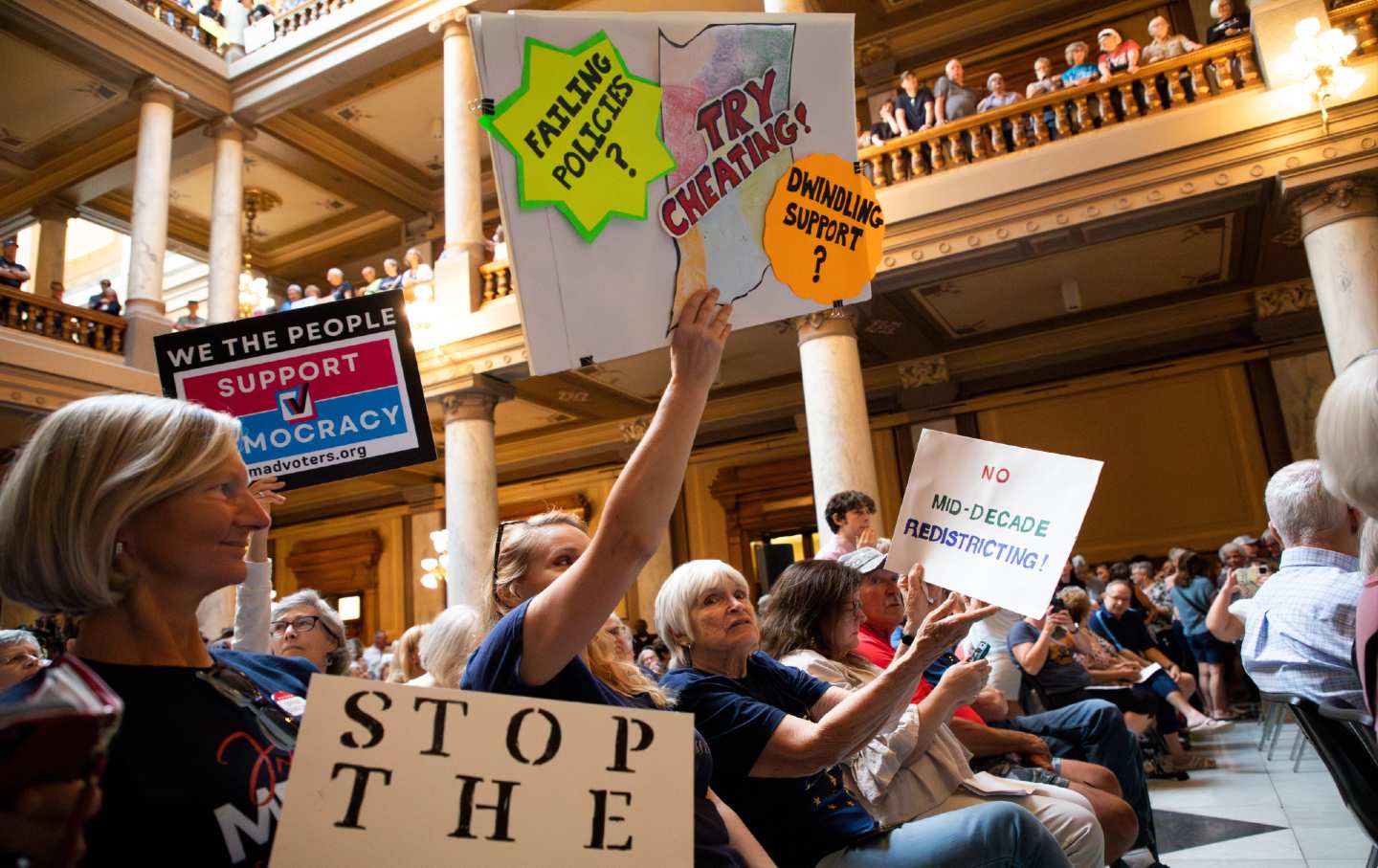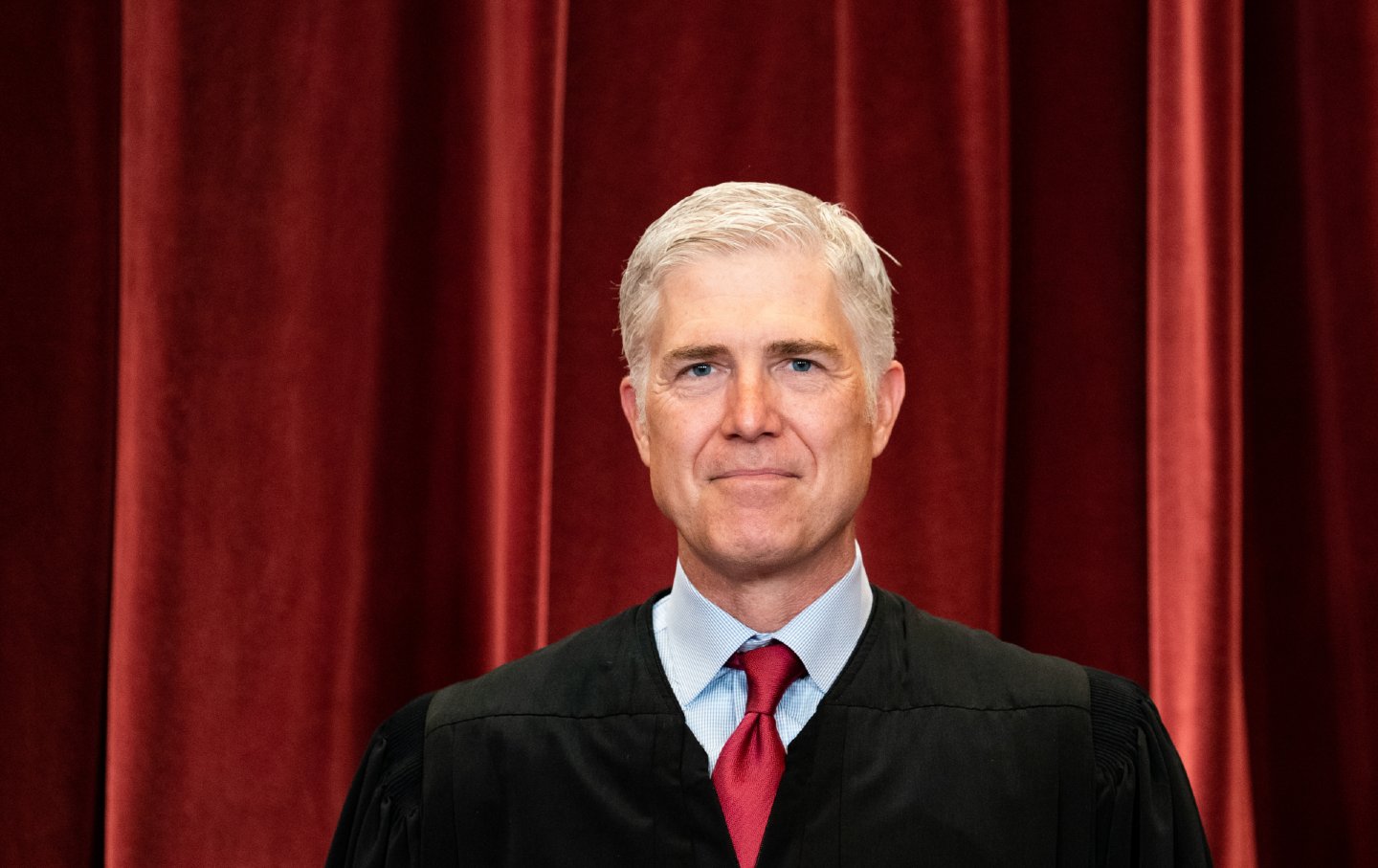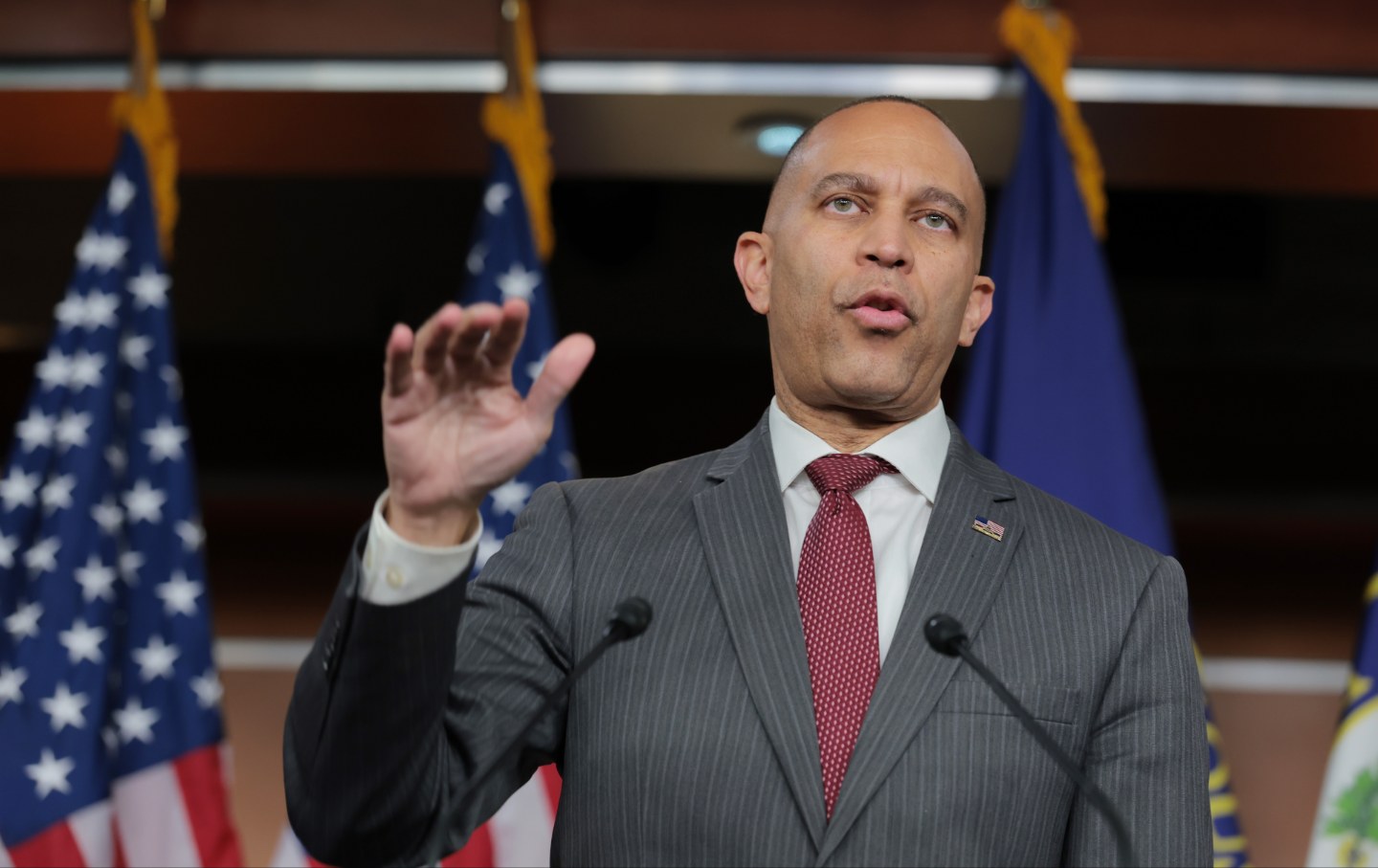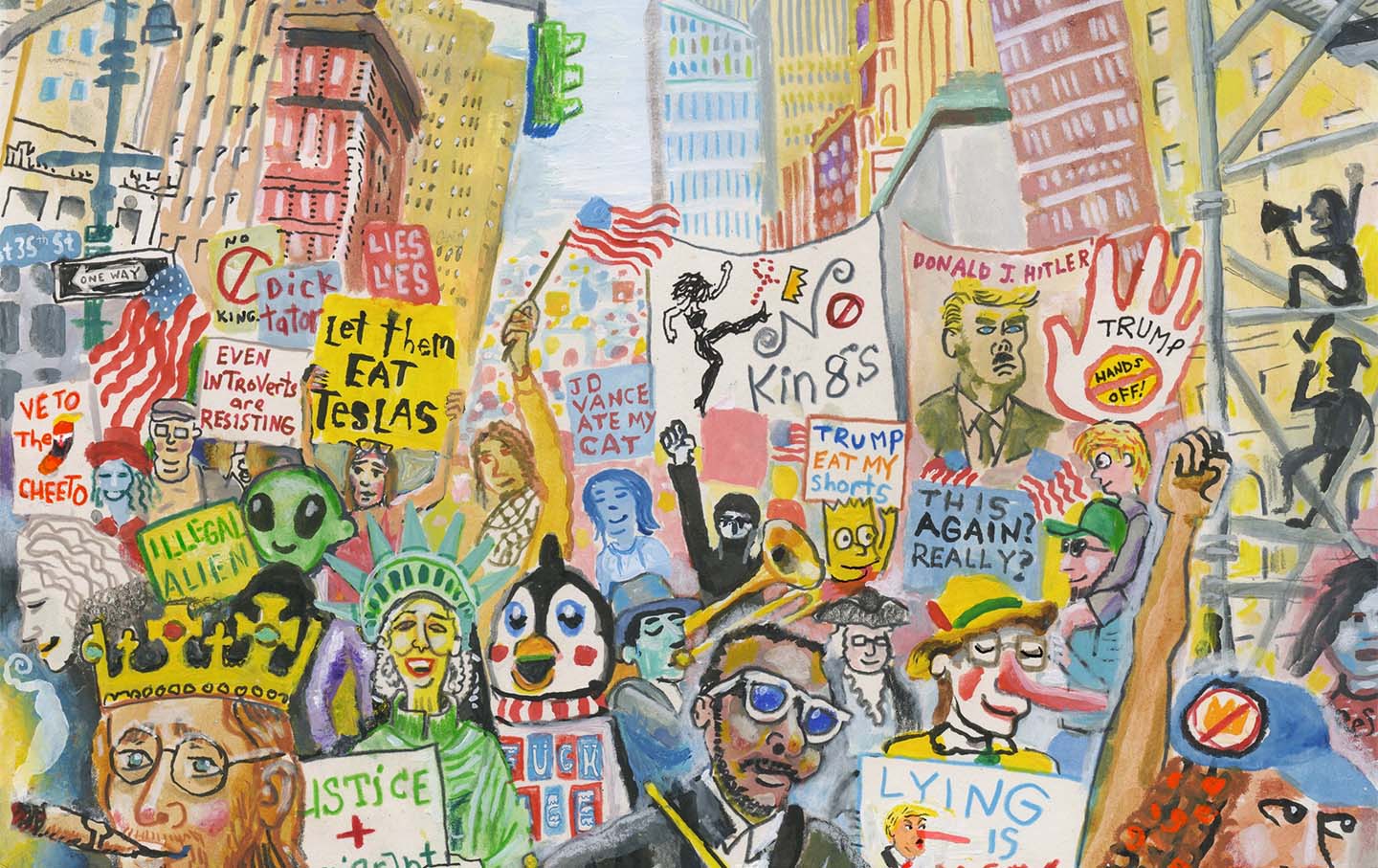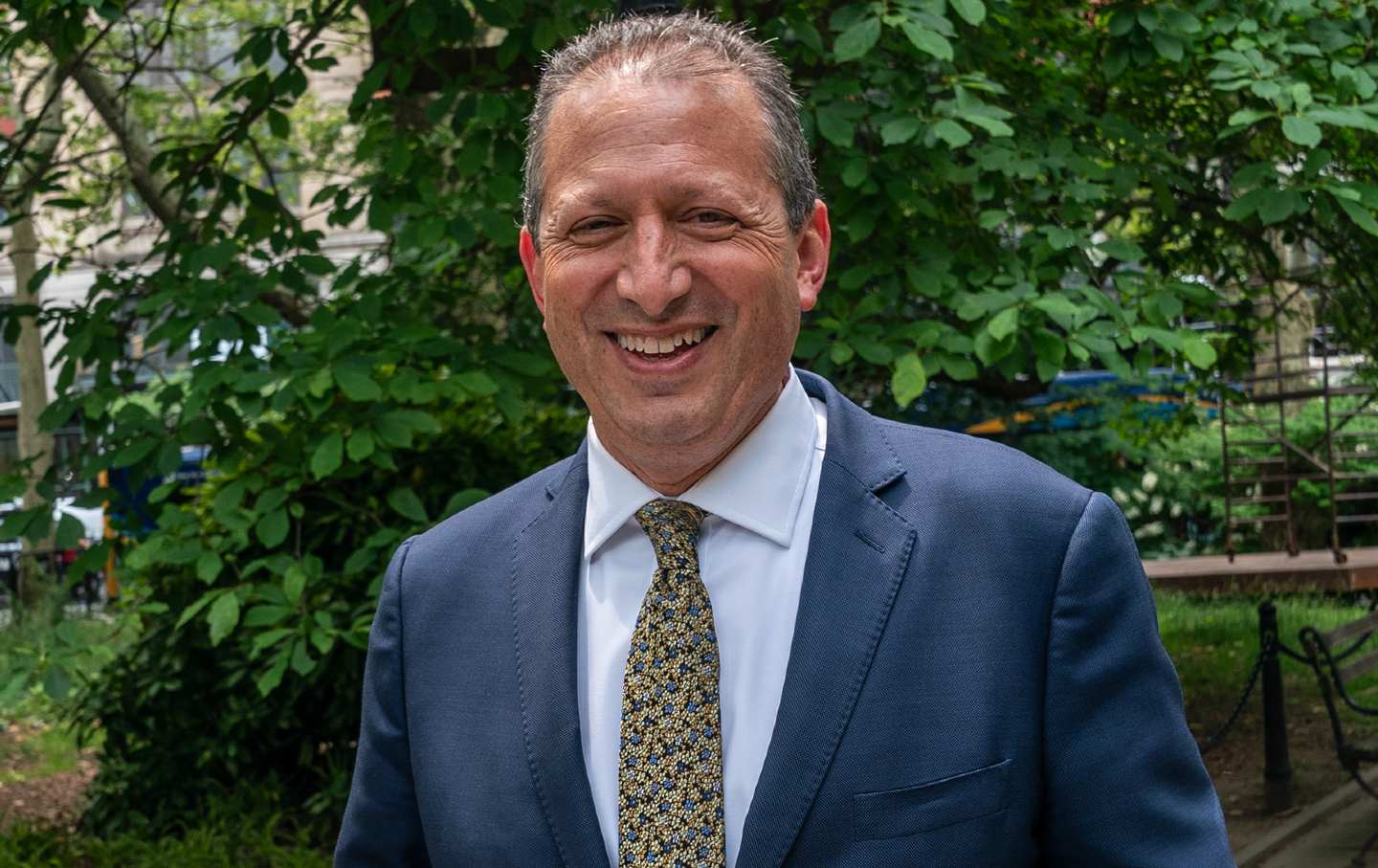
City Comptroller Brad Lander attends a rally to urge the State Assembly to pass Coverage for All legislation at City Hall Park.
(Lev Radin / Pacific Press/LightRocket via Getty Images)
New York Mayor Eric Adams has made himself enough of a lightning rod that the list of candidates lining up to oppose him is growing by the day. The latest is Brad Lander, the city comptroller.
A former city councillor representing the affluent Park Slope neighborhood of Brooklyn and the cofounder of the City Council’s Progressive Caucus, Lander has been described by The New York Times as one of the city’s most liberal politicians, and he counts housing and workers’ rights victories among his legislative achievements. But Lander joins a field that includes at least two other left-leaning candidates—former comptroller Scott Stringer and state Senator Zellnor Myrie—and the prospects of more to come.
On Thursday morning, Lander spoke to me about the mayoral race, his vision for New York, and whether voters really want to elect a progressive reformer amid uncertainty about the city’s finances and future.
—Bhaskar Sunkara
President, The Nation
Bhaskar Sunkara: You just announced your candidacy for mayor. How do you distinguish yourself from other progressives, like Scott Stringer or Zellnor Myrie who have also begun campaigns?
Brad Lander: Recent months have shown us we’re well served by robust primaries. It is valuable for people to put out their vision and their track record and introduce themselves to voters.
One thing Scott, Zellnor, and I all agree on is we need a new mayor, and we have time to be strategic about how to get one. I believe I’ve got the best experience and track record to deliver the results New Yorkers are so hungry for. I’ve been working my whole life on affordable housing and tenant protections and community development for a more affordable city. I worked a decade in the city council on legislation for a decent wage and dignity for workers including freelancers, baristas, and for-hire drivers.
Now in the comptroller’s office I’ve really rolled up my sleeves on [the question of] “How do we make government work?” People want good public schools and libraries and parks and sanitation and safety. It’s basic. It’s progressive to care about good-quality life across all neighborhoods and build the capacity of city government to deliver it.
BS: New York has ranked-choice voting. Will you commit to encouraging your supporters to rank other progressives a certain way in order to give us the best chance of beating Eric Adams?
BL: I was proud to be one of the supporters of ranked-choice voting and help bring it to New York City. So I’m a believer in ranked-choice voting. But I think it’s a little too soon. There will be time for airing out the strategy in the next few months.
BS: Let’s move on to some broader city issues. Is Mayor Adams right that the city is going broke, and if so, aren’t the mayor’s cuts or some other form of austerity necessary to save the city from bankruptcy?
BL: Mayor Adams is not right that the city is broke. It does need better fiscal management. He has largely used cuts and an austerity narrative to create problems in order to solve them. And a lot of the problems that he has “solved” are just problems he created. There was no need to cut libraries and parks and cultural institutions, and it was just scapegoating to blame that on asylum seekers. The City Council showed that revenue projections were ahead of what the Office of Management and Budget was showing.
Now, there are deficits, and we need a thoughtful and serious approach to address them, but that begins with more honest and transparent budgeting. Give commissioners the right incentives to control costs. Last year, we spent over $1.5 billion on claims against the city. That’s traffic crashes caused by city vehicles, that’s police misconduct, that’s deaths at Rikers. There’s no incentive for any of the commissioners or managers to reduce and control those claims. They’re paid out of the general fund and not shown in the agency budget. We put out a fiscal framework for giving commissioners incentives to control the expenses to give us more room to invest in the things that we do need and still meet our balanced budget requirements.
BS: That’s some of the restructuring that can take place, but your office also presented a series of options for the city to raise an additional $1 billion in revenue. Some of those involve raising the personal income tax on the top 1 percent of earners and imposing a surcharge on second homes. Do you support those policies?
BL: The proposals last year were statewide proposals reckoning with the end of stimulus spending, so the city wouldn’t lose the pre-K expansion, Summer Rising, the education programs that had been funded with pandemic stimulus. I’m happy to say that at the moment, city revenues have grown sufficiently to cover those expenses. And Mayor Adams, though he is not running 3-K and Pre-K well, has acknowledged that the city has the resources for universal 3-K and Pre-K, for Summer Rising, for mental-health programs. So that was the proposal last year.
I won’t take those off the table as things that might be needed in the future. At the moment, I believe we can do a lot more with what we have.
I think the framework for achieving savings in some areas so we can invest more in others is good. I’m excited by what New Yorkers for Childcare is doing, for example, in making a statewide proposal for universal childcare, which would require more revenue. Of course, there’s a long-standing dialogue about universal health care and single-payer health care. It would be better at the national level, but I’m a supporter of it at the state level. That would also require more revenue. So these models of progressive taxation, I think, would be necessary in those contexts. But at the city level, I think we can get a lot more with what we have.
BS: You mentioned safety earlier, and safety also featured in your campaign launch video. It’s reflective of the fact that crime and policing is an issue on the minds of many New Yorkers and part of Adams’s appeal with some voters. In 2020, you embraced the “defund” movement and some of its demands. Is it fair to say that your position has evolved on this question?
BL: You’re right, times change, and you’ve got to be responsive to what people are calling for. In the wake of the murder of George Floyd there was a national uprising for accountability, and rightly so. [But] the pandemic significantly elevated crime and mental illness, and thankfully crime has gone down some, but there’s still many categories where it is elevated well over what it was before the pandemic. People are concerned. I think there are ways to address that that are progressive and pragmatic.
The campaign promise I’m making that focuses on safety is to end street homelessness of severely mentally ill people in New York City. When I talk to people about the anxiety people feel in the city, this is a big one.
We don’t have to have homeless and mentally ill people in the richest city in the world. So we made a plan to have a continuum of care that focuses on connecting people with stable housing and services, and a New York City that doesn’t have mentally ill people sleeping on the streets would be a New York City that is safer for mentally ill homeless New Yorkers and all New Yorkers.
BS: Mayor Adams has echoed at least some of those sentiments and said that we have a “moral obligation” to help people who are mentally ill, but in the context of talking about involuntary commitment. How do you navigate the difficulties of having a communitarian goal to take care of the mentally ill and concerns about people having their autonomy and freedom taken away?
BL: I don’t believe the standard for involuntary commitment should be changed. The mayor has proposed to make it more aggressive.
The challenge at the moment is that we don’t have a continuum of care, so hospital beds are full. It would be good to have a few more hospital beds, but most of those hospital beds are full, because there’s nowhere to discharge people. We don’t have enough supportive housing beds or a housing-first system, so if they do get discharged, then they’re just right back on the street. If we had the continuum of care we need and you connect more people to the combination of stable housing and services, you’ll have a lot less of this problem.
BS: In the City Council, you were involved in the rezoning of Gowanus. Can you tell me broadly about your strategy to use the mayor’s office to help solve the city’s housing crisis? Do you have any overarching beliefs about the role of public housing or rent control as part of a strategy to create affordable housing?
BL: This is the thing I’ve been doing the longest. Before I was in an elected office, I had a 15-year career in affordable housing and community development, running two nonprofit organizations, 5th Avenue Committee and the Pratt Center for Community Development.
My belief is that growth has to genuinely work for working people, and they have to see themselves in it, not be displaced or harmed by it, and have faith that it’s going to deliver a more thriving and inclusive city. That’s a lot of work, but there are tools that do it. I believe we did very well in the Gowanus rezoning to deliver that.
We had a pretty extensive participatory planning process. We had a lot of stakeholders at the table. There’s actually an article today in City Limits [saying] that the $200 million of repairs for the nearby public housing developments that we insisted on as part of that plan are starting to be spent. People worry, but public-housing stakeholders were at the table. We built a really strong coalition. We won that money, and we actually even included an oversight structure to make sure it got delivered.
We thought a lot, of course, about affordable housing and the biggest chunk of affordable housing that we could get in the mix, but also, how do we preserve room for artists and manufacturing, create new open space, address the infrastructure and climate issues that are coming as a result of growth. As a result, the local community board voted overwhelmingly to support the rezoning. It’s the largest rezoning of the last decade that will create the most affordable housing and was the most supported by its community. And I do think it’s a good model.
One thing I wish it had more of, and I really want more of at a citywide scale, is affordable, cooperative homeownership essentially a modernized version of the Mitchell-Lama or Co-Op city or the Penn South program that enables working-class folks to become homeowners. That’s a great tradition in the city. It’s an anchor for mixed-income communities with working-class and middle-class people. New York used to do it better than anybody else in the US and as well as anybody around the world. And we stopped 70 years ago. We should start it again, partly because it’s a good idea on its own, and partly because I really believe it will make people much more open to the housing growth that we need.
And yes, I’m a longtime supporter of rent regulation and think that you invest in and preserve and strengthen public housing.
BS: Let’s turn to what’s been called the migrant crisis. Obviously, as many as 200,000 migrants have entered New York. They’re unable to work due to their status—or at least work in the formal economy. And billions have been spent on the shelter system, where around 75,000 of these people are living. Mayor Adams has pointed to the need for more help from the federal government, but can you talk about some of the other solutions you would pursue?
BL: It’s worth starting by saying New York City is the greatest immigrant city that the world has ever known. That’s been true for generations, and we need to make it true for generations more.
That requires more effective management. We do need more resources from Washington. The refugee resettlement model that the federal government funded for people from Ukraine and Afghanistan needs to be in place for people who are here seeking asylum and awaiting the processing of their cases, but the city can do a lot better at managing things along the way. That means a stronger focus on helping people submit their asylum applications and get work authorization.
Six months is too long to wait. But you can set things up so that that works more effectively. You help people fill out their asylum application or TPS [Temporary Protected Status], and then six months later, they’re eligible for work authorization, and you can use the time in between to help with English language and workforce development and helping people get jobs, and even in some cases, pay them stipends for work, providing childcare in the shelter, or a range of other things people could be doing as part of that transition. But the way the mayor has disrupted the shelter system with the 30- and 60-day rules is making that much harder.
We’re not keeping track of people’s mail, so in some cases, their paperwork from the federal government is getting lost, and we’re definitely not running a more coordinated system that would get people to apply for status with work authorization and being supported in the path to work, which is what they overwhelmingly want.
BS: Mayor Adams and his supporters immediately responded to your candidacy by pivoting to questions of identity. The line goes: “Instead of trying to elect the first Black woman president, you’re trying to oust the second Black mayor.” I’m normally very adverse to these sorts of appeals, but there is something striking about the voting base that you seem to be starting out with. You’re a white progressive from Park Slope, and your strongest base is college-educated professionals.
Are you concerned with your ability to reach Black voters and working-class voters throughout the city? And, more broadly, do you think there’s a problem with progressive politics in the city that our base seems disconnected from organized labor or, in many cases, the working-class communities that are the beneficiaries of many of the policies we advocate for?
BL: My whole career has been building broad coalitions to deliver the results that enable a genuinely inclusive and thriving New York City. Working on affordable housing in an organization that was led by people of color, working closely in the council with labor unions and other workers’ rights organizations on groundbreaking protections for Fast Food workers, for deliveristas, for Lyft drivers. The coalition we built to desegregate the schools of District 15 included progressives from Park Slope who believed in the more diverse school system, but it included Black families living in public housing in Red Hook and working-class Latinos in Sunset Park. And we did that together.
The same was true in Gowanus, that coalition included public housing residents and working-class folks and upper-middle-class folks. So in the set of people that supported me and who I’ve tried hard [to reach] all my career, in partnership with the Working Families Party, partnership with labor unions. Of course, that’s the challenge that I have and anyone has who wants to build a majoritarian coalition for governing New York City in a way that delivers the goods: better quality of life, more affordability, more livable neighborhoods, good public services all across the city. That’s a great challenge to have, and I look really forward to leaning into it.
Disobey authoritarians, support The Nation
Over the past year you’ve read Nation writers like Elie Mystal, Kaveh Akbar, John Nichols, Joan Walsh, Bryce Covert, Dave Zirin, Jeet Heer, Michael T. Klare, Katha Pollitt, Amy Littlefield, Gregg Gonsalves, and Sasha Abramsky take on the Trump family’s corruption, set the record straight about Robert F. Kennedy Jr.’s catastrophic Make America Healthy Again movement, survey the fallout and human cost of the DOGE wrecking ball, anticipate the Supreme Court’s dangerous antidemocratic rulings, and amplify successful tactics of resistance on the streets and in Congress.
We publish these stories because when members of our communities are being abducted, household debt is climbing, and AI data centers are causing water and electricity shortages, we have a duty as journalists to do all we can to inform the public.
In 2026, our aim is to do more than ever before—but we need your support to make that happen.
Through December 31, a generous donor will match all donations up to $75,000. That means that your contribution will be doubled, dollar for dollar. If we hit the full match, we’ll be starting 2026 with $150,000 to invest in the stories that impact real people’s lives—the kinds of stories that billionaire-owned, corporate-backed outlets aren’t covering.
With your support, our team will publish major stories that the president and his allies won’t want you to read. We’ll cover the emerging military-tech industrial complex and matters of war, peace, and surveillance, as well as the affordability crisis, hunger, housing, healthcare, the environment, attacks on reproductive rights, and much more. At the same time, we’ll imagine alternatives to Trumpian rule and uplift efforts to create a better world, here and now.
While your gift has twice the impact, I’m asking you to support The Nation with a donation today. You’ll empower the journalists, editors, and fact-checkers best equipped to hold this authoritarian administration to account.
I hope you won’t miss this moment—donate to The Nation today.
Onward,
Katrina vanden Heuvel
Editor and publisher, The Nation

